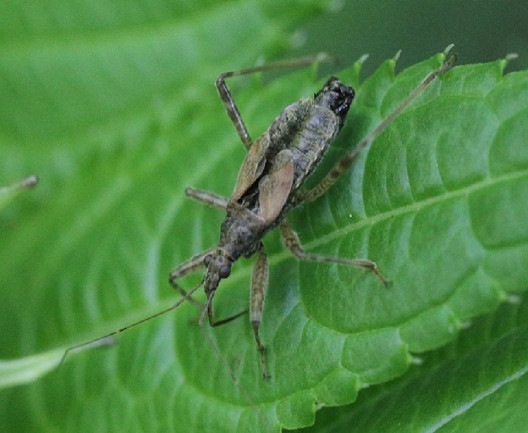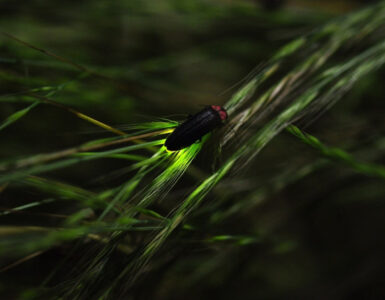One way of controlling pests is to use beneficial insects like ladybugs, lacewings, and parasitic wasps. Damsel bugs are also helpful, and you should encourage them in your garden.
Natural means of pest control are part of the organic response to defend a garden from pests. The Damsel Bug (or Nabid bug) helps keep destructive insects under control.
Identification
The word ‘bug’ is often used for a variety of insects. However, damsel bugs are friendly bugs in the order Hemiptera, from the family Nabidae [1].
There are hundreds of different species in this order, and most are predators that feed on a variety of pests.
These small bugs are tan or yellow-brown, with long front legs that they use to grip their prey. When they fold their wings, they make an X pattern on their backs.
Their most significant feature is the ‘beak’ (rostrum). This is a piercing, needle-like protuberance from the mouth, tucked under the chin when not in use.
They also exhibit bulbous eyes on slim heads and long, noticeable antennae.
The Usefulness of Damsel Bugs
Nabids have big appetites and eat whatever they find. They may consume any insects that come close.
They target many garden pests. They primarily feast on “herbivores” like leafhoppers, aphids, four-lined plant bugs, and cabbage worm caterpillars.
They also get through eggs, larvae, thrips, and spider mites in their daily hunts.
Farmers also find them helpful in controlling the population of Colorado potato beetles, which feed on the eggs and nymphs.
Unfortunately, they also consume some beneficial insects. However, they effectively reduce harmful pest populations. This makes them essential for pest management.
Differences from Other Bugs
The main difference is in the use of their beaks. Bugs can damage plants by piercing them with their beaks and sucking out the sap.
Damsel bugs (DBs) use this appendage instead to pierce prey and inject digestive enzymes to kill them. They then suck out the body contents, thus remaining harmless to plants.
Their long and strong front legs enable them to move quickly. Therefore, they can eliminate vast numbers of pests before being devoured by other predators.
Life Cycle
Female damsel bugs lay large numbers of eggs in plant tissue, where they hatch about a week later. The nymphs that emerge are similar to the adults but without wings, and start to feed immediately on anything in the vicinity.
The nymphs develop over 3-4 weeks [2], moving into adulthood. This usually occurs from spring onwards, and both nymphs and adults will attack and eat insect pests.
How to Attract Damsel Bugs
Adult DBs will overwinter in vegetation in sheltered conditions, particularly favoring grain plants. You can find them in cotton fields, soybeans, and other legume crops.
Alfalfa and certain grasses also provide a winter home and spring/summer egg-laying environment for the bugs. As a result, growing these plants will help attract the DBs.
1. Flowers and Herbs That Attract Damsel Bugs
Marigolds (Tagetes tenuifolia) are excellent for attracting beneficial insects, including DBs. They’re among the best ornamentals to plant.
They have the added benefit of being bright, attractive, and easy-to-grow plants for the garden. Cosmos, goldenrod, and lavender are other flowers that a variety of beneficial insects, including DBs, favor.
Herbs include fennel, spearmint, dill, coriander, and chamomile. Also, certain clovers can attract these beneficial bugs as well.
On the flip side, planting attractive flowers and herbs will also attract birds, spiders, and other predators of damsel bugs.
Again, it is a balancing act between attracting these helpful bugs and bringing in their killers. Some beneficial insects will eat each other, and DBs can even eat their own families!
2. Limit Pesticide Use
They are also known to be more susceptible to organic pesticides than other insect predators. So, use these products with caution.
3. Commercial Products
Other beneficial insects, like the fabulous ladybug and the green lacewing, have been successfully bred for sale.
This has not been so with damsel bugs to date. However, this may change in the future as breeders continue to experiment with achieving this.
Some organic gardeners have grown plant seeds to draw in beneficial insects, such as damsel bugs. This remains the best way to encourage these beneficial bugs in the garden.
4. Other Pests
Planting flowers and herbs that are attractive to damsel bugs will also bring harmful insects. Thus, providing a source of food for egg-laying females, nymphs, and adults.
This is a matter of balance. The organic gardener has to tolerate some plant pests to attract and keep beneficial insects in the garden.
The speed of DBs and the number of insects consumed by both nymphs and adults should control the pest problem with only minimal plant damage.
Takeaway
Integrated Pest Management is a means of biological pest control. It uses natural products and encourages the use of natural predatory insects.
The facts are clear. If you are looking for bugs that eat aphids and other pests, damsel bugs are your best bet. They are essential in this system due to their speed of movement and their ability to attack almost any pests.
Both nymphs and adults feed voraciously and help the organic gardener protect crops against a variety of harmful insects.
These beneficial bugs can thrive and be of great benefit in the garden. Moreover, the use of organic farming methods and the right plants can attract them.








Add comment